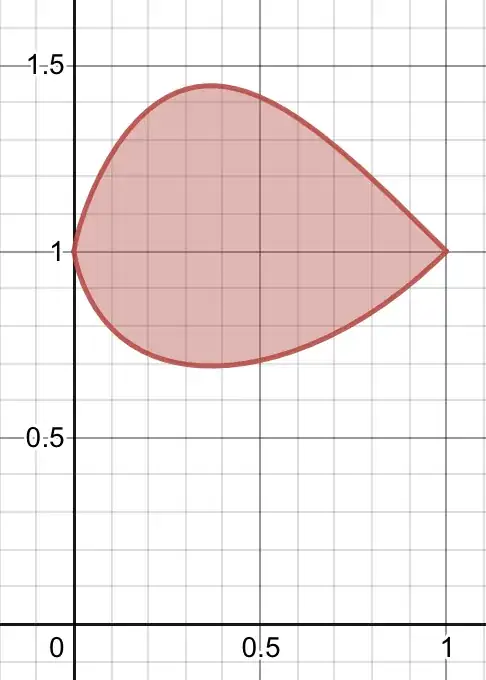I was recently trying to compute the arc length of $x^x$ from $0$ to $1$ as follows:
$$L=\int_0^1 \sqrt{1+\left(\frac{\text{d}}{\text{d}x}x^x\right)^2} \text{d}x=$$ $$\int_0^1\sqrt{1+x^{2x}(\ln x+1)^2} \text{d}x=$$ Using the infinite series expansion for the binomial theorem with |x|<1, we can rewrite the square root portion as $\sqrt x=x^{1/2}$. We can assume a limit for x=1 in the integral bounds: $$\int_0^1 \sum_{n=0}^∞ \binom{\frac 12}{n} (x^{2x}(\ln x+1)^2)^n \text{d}x=$$ $$\sum_{n=0}^∞ \binom{\frac 12}{n} \int_0^1 e^{2nx\ln(x)}(\ln x+1)^{2n}\text{d}x=$$
It would be maybe easier to expand out the exponential as a series with a different index to have another series with an independent index so that no cauchy products are needed:
$$\sum_{n=0}^∞ \binom{\frac 12}{n} \int_0^1 \sum_{m=0}^∞\frac{2^mn^mx^m\ln^m(x)}{m!}(\ln x+1)^{2n} \text{d}x=$$ $$\sum_{n=0}^∞ \binom{\frac 12}{n} \sum_{m=0}^∞\frac{2^mn^m}{m!} \int_0^1 x^m\ln^m(x)(\ln x+1)^{2n}\text{d}x=$$ Then the exponentiated logarithmic part of this expression, if we only focus on it, can be expanded into another similar summation using a binomials expansion because the index of n is an integer by definition: $$\sum_{n=0}^∞ \binom{\frac 12}{n} \sum_{m=0}^∞\frac{2^mn^m}{m!} \int_0^1 x^m\ln^m(x)\sum_{l=0}^{2n}\binom{2n}{l}\ln^l(x)\text{d}x=$$ $$\sum_{n=0}^∞ \binom{\frac 12}{n} \sum_{m=0}^∞\frac{2^mn^m}{m!} \sum_{l=0}^{2n}\binom{2n}{l} \int_0^1 x^m\ln^{l+m}(x)\text{d}x$$ This integral can be found in terms of the factorial and a “factorial coefficient” part. Using the substitution of u=-ln(x) gets us: $$\int_0^1 x^m\ln^{l+m}(x)\text{d}x=$$ $$(-1)^{l+m}\int_0^ ∞e^{-u(m+1)}u^{l+m}\text{d}u=$$ $$-(-1)^{l+m+1}m^{l+m+1}Γ(l+m+1,-(m+1)\ln(x))|_0^1=$$ $$(-1)^{l+m}m^{l+m+1}(l+m)!$$ The incomplete gamma function is here. This means our final possible answer is: $$L=^? \sum_{n=0}^∞ \binom{\frac 12}{n} \sum_{m=0}^∞\frac{2^mn^m}{m!} \sum_{l=0}^{2n}\binom{2n}{l} (-1)^{l+m}m^{l+m+1}(l+m)!=$$ $$\sum_{n=0}^∞ \binom{\frac 12}{n} \sum_{m=0}^∞\frac{2^mm^{m+1}n^m}{m!} \sum_{l=0}^{2n}\binom{2n}{l} (-1)^{l+m}m^l(l+m)!=^?1.2474...$$
This series diverges maybe because of a bad usage of the summations with the interval of convergence being too small. My main question is if all of these steps are correct as in my previous deleted question. Sorry for the undetailed question. Also, please correct and simplify the problem as much as possible using any widely used function. I.e. do not just do arclength(f(x),a,b).
I tried a similar method which also diverges even though the surface area should not of the same figure but with $(y-x^x)(y-x^{-x})=0$, $0\le x\le 1$ which got me to a similar answer. This one had $$S_y=\int_0^1 x^x \sqrt{1+\left(\frac{\text{d}}{\text{d}x}x^x\right)^2} \text{d}x$$. This one experimentally had 5 summations with different indices by accident when I was trying to calculate the arc length. The area of this figure is simply the difference two sophomore dream integrals.
This is $$A=\sum_{N=1}^ ∞\frac{1+(-1)^N}{N^N}=.507...$$ as n as an index was already defined.
I was also trying to find the perimeter of the lamina and volume of this solid of revolution about both the x and y axes all or which are quite ambitious to figure out and very tricky as I most likely got this wrong except for the area of this figure. Please just figure out the arc length and all will be well:
Here is the desmos demo of this arc length series:
https://www.desmos.com/calculator/gt0hsg40ah
If this is true, please expand the binomial coefficients and simplify the rest. Maybe keep the original form.
Thanks, and please give me feedback!

N[ArcLength[{x, x^x}, {x, 0, 1}], 10]). That's not really of any help to you, but at least suggests you didn't make a mistake so far. – Patrick Stevens Apr 12 '21 at 22:52